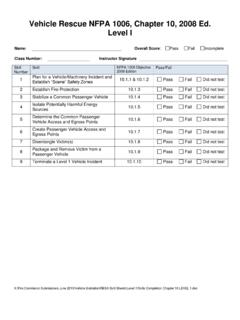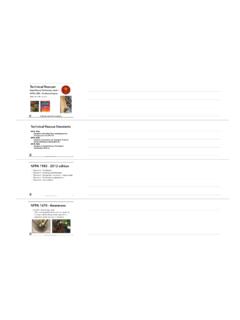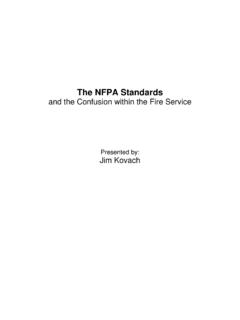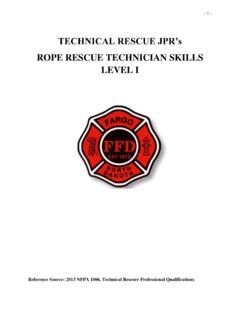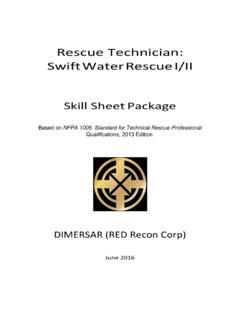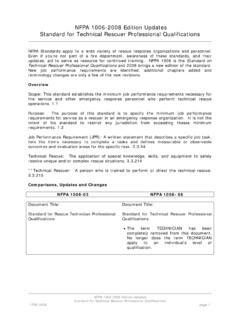Transcription of NFPA 1006 Skills Evaluation Check Sheet - REACT
1 Version nfpa 1006 - 2008 editionYesNoYesNo123456789101112 PassPassFailFailDirections: Given the allotted equipment, you are to descend a fixed rope system with a minimum working height of 20ft, engage an obstacle during the descent, and work your way past the obstacle in order to continue your descent to the ground. Do you have any questions? nfpa 1006 Skills Evaluation Check SheetSKILL Sheet COMPLETE AN ASSIGNMENT WHILE SUSPENDED - SELF RESCUES tudent #:JPR Level 2 Rope Rescue - MandatoryDate:Student Name:Descends rope is a controlled manner and engages obstructionTaskProperly dons an approved Class II or II/III combination harnessAttaches descent control device to rope and harnessSelects appropriate equipment to perform surroundings for potential hazardsTask NumberInitial TestProperly uses rope grab device to take load off of and reapply load to descent control deviceRemoves descent control device from rope and places it on rope below obstructionWere all tasks completed in a SAFE manner?
2 ( NO indicates automatic failure)Removes rope grab device from over to descent in a controlled mannerContinues descent to groundProperly attaches rope grab device to rope and harnessPerforms a system safety Check of existing fixed rope system (visual, load test and audible).Pass/Fail Criteria: Any "No" constitutes a failure of the Signature (retest):Evaluator Signature (initial):Evaluator Comments:Version nfpa 1006 - 2008 editionYesNoYesNo1234567813 PassPassFailFailPass/Fail Criteria: Any "No" constitutes a failure of the Signature (retest):Evaluator Signature (initial):Evaluator Comments:Were all tasks completed in a SAFE manner? ( NO indicates automatic failure)Simulated patient (mannequin) is positioned in patient transfer device and secured appropriately using webbing/rope so as to minimize any movement during successfully lowered to safety in a controlled mannerDate:Student Name:Rescue needs are assessed and communicatedDirections: Move a victim in a high-angle environment, given a rope rescue system, a minimum vertical travel distance of 20 ft.
3 , victim transfer devices, and specialized equipment necessary for the environment, so that risks to victim and rescuers are minimized, undesirable victim movement within the transfer device is minimized, means of attachment to the rope system is maintained, the victim is removed from the hazard, selected specialized equipment facilitates efficient victim movement, and the victim can be transported to the local EMS NumberTaskInitial TestRetestReduces hazards for rescuers and victims as much as possibleA system safety Check is performed (visual, load test and audible) nfpa 1006 Skills Evaluation Check SheetSKILL Sheet HIGH ANGLE VICTIM LOWER AND LITTER TENDINGS tudent #:JPR Level 2 Rope Rescue - MandatoryProperly attaches victim transfer device to the rope rescue systemProperly chooses victim transfer device and any needed specialized equipmentSelects and uses proper PPEV ersion nfpa 1006 - 2008 editionYesNoYesNo12345613 PassPassFailFailNFPA 1006 Skills Evaluation Check SheetSKILL Sheet FUNCTION AS A LITTER TENDERS tudent #:JPR Level 2 Rope Rescue - MandatoryEvaluates surroundings for potential hazardsDate:Student Name:Directions: Function as a litter tender in a high angle environment, given a rope rescue system, a minimum vertical travel distance of 20 ft.
4 , litters, bridles, and specialized equipment, so that risks to victim and rescuers are minimized, the means of attachment to the rope system is secure , and the terrain is negotiated while minimizing risks to equipment or NumberTaskInitial TestRetestManeuvers the litter past obstacles or natural structural featuresManages the litter while suspendedProperly attaches the life safety harness to the rope rescue systemSelects and uses proper harness and PPES elects and uses proper PPEWere all tasks completed in a SAFE manner? ( NO indicates automatic failure)Pass/Fail Criteria: Any "No" constitutes a failure of the Signature (retest):Evaluator Signature (initial):Evaluator Comments:Version nfpa 1006 - 2008 editionYesNoYesNo1234512 PassPassFailFailPass/Fail Criteria: Any "No" constitutes a failure of the Signature (retest):Evaluator Signature (initial):Evaluator Comments:Were all tasks completed in a SAFE manner?
5 ( NO indicates automatic failureDate:Student Name:Selects and constructs a system for rapid removal of the victim Directions: Direct the team in the removal of a victim suspended from rope or webbing in a high-angle environment, given a victim suspended by a harness attached to anchored rope, devices for removal of the victim and a means of removal of the victim to the ground or safe area, so that risks and injury are minimized, means of attachment to the rope system is maintained, the victim is removed to safety and transferred to EMSTask NumberTaskInitial TestRetestDetermines special equipment needed for victim rescueNFPA 1006 Skills Evaluation Check SheetSKILL Sheet ONE PERSON PICK-OFFS tudent #:JPR Level 2 Rope Rescue - MandatoryReduces hazards for rescuers and victim as much as possibleManages the operation of the systemDetermines suspended victims conditionVersion nfpa 1006 - 2008 editionYesNoYesNo12345678910111213 PassPassFailFailPass/Fail Criteria: Any "No" constitutes a failure of the Comments:Simulated rescue load is attached to the system in a safe manner so that the load is secureTeam directs the movement of the simulated rescue load in a clear and concise mannerRescue load is moved to a predetermined point in a safe manner and can be secured at any point during the movementWere all tasks completed in a SAFE manner?)
6 ( NO indicates automatic failure)Control lines are rigged to either simple mechanical advantage systems or a descent control devices as system warrants based on rescue objectivesSystem safety Check is performed (visual, load test and audible).Simulated rescue load (mannequin) is appropriately packaged in a patient transfer device so as to not aggravate any potential injuries, movement within the device is minimized, and victim has appropriate personal protective equipment for the situationDate:Student Name:Is able to determine incident needs as related to highline constructionDirections: Direct a team in the construction of a highline system, given rescue personnel life safety rope, rope rescue equipment, a minimum span of 20 ft, and suitable anchor system capable of supporting the load, so that personnel assignments are made and clearly communicated, the system constructed can accommodate the load, tension applied with in the system will not exceed that rated capacity of any of its component parts, a system safety Check is performed, movement on the system is efficient.
7 And loads can be held in place e or moved with minimal effort over the desired distanceTask NumberTaskInitial TestRetestTrack line tension is appropriate for system and does not exceed acceptable safety margins for rope and hardware (500# on dynamometer for unloaded systems or 10 % of sag per 100 foot span per 200# load).Pulley/trolley system is placed on track line(s) and control lines are attached to the trolley systemNFPA 1006 Skills Evaluation Check SheetSKILL Sheet CONSTRUCT A HIGHLINE ROPE RESCUE SYSTEMS tudent #:JPR Level 2 Rope Rescue - MandatoryTrack line(s) is tensioned using a simple mechanical advantage system on near side and is anchored appropriately (3:1 or 4:1 system). * Soft rope grab devices (prusiks) should be utilized to warn of system overloadEvaluates the incident site interference and set-up concernsIdentifies obstacles or voids to be negotiated with the highlineVersion nfpa 1006 - 2008 editionEvaluator Signature (retest):Evaluator Signature (initial):Version nfpa 1006 - 2008 editionYesNoYesNo123456713 PassPassFailFailCommunicates effectivelyEffectively manages movement of the loadNFPA 1006 Skills Evaluation Check SheetSKILL Sheet DIRECT THE OPERATION OF A HIGHLINE ROPE RESCUE SYSTEMS tudent #:JPR Level 2 Rope Rescue - MandatorySelects and assigns personnelCompletes a system safety checkEvaluates system components for compromised integrityDate:Student Name.
8 Determines incident needsDirections: Direct a team in the operation of a highline system, given rescue personnel, an established system with a minimum span of 20 ft, a load to be moved and PPE, so that the movement is controlled, the load is held in place when needed, operating methods do not stress the system to the point of failure, personnel assignments are made and tasks are communicated, and potential problems are identified, communicated, and managedTask NumberTaskInitial TestRetestWere all tasks completed in a SAFE manner? ( NO indicates automatic failure)Evaluates for any potential problemsPass/Fail Criteria: Any "No" constitutes a failure of the Signature (retest):Evaluator Signature (initial):Evaluator Comments.


